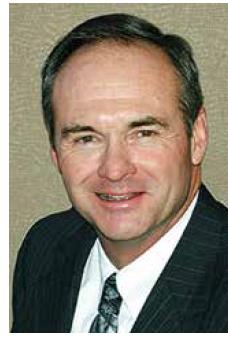
Dressed in a light-grey suit, Cimarex Energy Co. chairman, president and CEO Tom Jorden gave a crisp welcome and, in a no-nonsense clip, empathized with the blank stares of investors looking for solid ground beneath them. Perhaps more bluntly than other speakers at EnerCom Inc.’s The Oil & Gas Conference in Denver in August, Jorden summed up the prospects for the industry. The truth, he said, is he doesn’t know if oil prices are now high or low—or if natural gas prices will rise or fall.
“The rescue ship is not coming to save us,” he said. “I don’t look to OPEC to save any of us. I don’t look for macro-forces to save us.”
At podiums and on large TV screens, leaders of E&Ps gave presentations with variations of the same notes: capital discipline, high-quality assets, staggering well results.
Cimarex Energy Co.'s focus is on getting its assets to perform and turn a profit, said CEO Tom Jorden.
But A&D aspirations brushed up against talk of prudence, tidy balance sheets and recent layoffs. More often, the deals stole the show, with Whiting Petroleum Corp. catching attendees off guard with a $500-million sale of some of its Williston Basin holding.
Denbury Resources Inc. president and CEO Chris Kendall described the company’s vast resources, as it has reduced capex by $50 million to $250 million and, in early August, pared its workforce 15%.
The company is exploring selling excess CO2, to industrial and other potential users. And Denbury has sold commercial property in the Houston area that he said wasn’t of any use.
“Fundamentally … to be sustainable, to be profitable, in the long term, Denbury needs to be positioned for a $50 world,” he said. “And we’re working through that right now.”
Yet Kendall mixed the company’s belt-tightening message with a report on a pair of acquisitions. Denbury closed the deals this year in Mississippi and Wyoming for a total of $87.5 million.
WPX Energy Inc. laid out its strategy to lower debt even as it promoted the opportunities presented a March purchase of Panther Energy II LLC and Carrier Energy Partners LLC assets in the Delaware Basin for $775 million.
COO Clay Gaspar said WPX intends to reduce its 4x net debt-to-EBITDAX ratio to less than 2.5x by year-end 2018. WPX’s answer is to spend within cash flow and avoid cutting corners while simultaneously “looking to de-lever through the drillbit,” he said.
The company’s meticulous preparation for ramping up in the Delaware also led to the discovery that its Wolfcamp D-zone resource is largely gassy and about 30% oil.
He added that WPX plans to sell about 130,000 net acres in the northern portion of its San Juan Basin assets. The southern San Juan assets will remain in the portfolio, but the north has always been viewed as a backup for a time when gas might return to competitive pricing.
A day after Whiting chairman, president and CEO Jim Volker noted the company’s solid balance sheet and $2-billion liquidity at EnerCom, the company announced it would sell nearly 30,000 net acres in the Fort Berthold area of North Dakota for $500 million.
Charles Robertson II, an E&P analyst at Cowen and Co., said in an August report that the sale dominated EnerCom conversations.
“Whiting sees the potential for additional asset sales in noncore Bakken” that have similar, low production profiles,” Robertson’s report said. Seaport Global Securities LLC analysts went further, saying Whiting would even consider a sale of the company “in an effort to extract the most value for shareholders.”
Also in the Williston, SM Energy Co. may try again to offload its assets in Divide County, N.D.—but only if oil prices climb, Seaport Global Securities said.
Carving and selling
Yet even A&D activity isn’t assured.
The CEOs of Range Resources Corp., Sanchez Energy Corp. and Jagged Peak Energy Inc. talked potential stumbling blocks in their path toward executing A&D in areas such as the Delaware Basin and the Eagle Ford and Marcellus shales.
Range chairman, president and CEO Jeff Ventura said the company has several assets it will consider divesting to lighten its debt load, which he said is still in the 40% range. One option is divesting in the Midcontinent, where the assets, “even if prices were higher, they’re noncore to us right now,” he said.
In the Marcellus, Ventura said, “Northeast Pennsylvania, you could argue, is not core to us, given the big position we hold down in the southwest. It’s high-quality acreage, but it’s not core.”
Additionally, Range has 9,000 surface acres in Pennsylvania in which it owns all depth rights.
“We’ll continue to look at, are there pieces … that would be worth more to somebody else than they are to us,” Ventura said.
Range Resources is still suffering market negativity since its purchase of Memorial Resource Development Corp.’s Louisiana assets in 2016.
Its market cap has fallen to $4.9 billion—a figure in the ballpark of what it paid for Memorial.
“We have a higher leverage ratio than some of our peers, even pre-Terryville (Field that was gained from Memorial),” Ventura said. Post-Terryville, “I think there’s just uncertainty over the acquisition. We got off, clearly, to a slow start.”
Ventura said third-quarter results should show its new Terryville wells on track.
The war zone
In the Delaware, Jagged Peak faces its own dilemmas.
Since the beginning of 2017, the company has acquired about $48.5 million in assets. It is looking to acquire more and has no debt due.
Since IPOing earlier this year with 61,000 net acres, it has added about 9,000.
Chairman, president and CEO Joe Jaggers described the process as “hand-to-hand combat in courthouses.
“We haven’t done anything of any size out there,” he said. “I think probably the biggest piece we’ve picked up is a two-section piece out there.”
The problem is the Permian’s long history of being drilled and into myriad horizons.
“This has obviously been a producing area at different horizons for the last 50 years,” he said. “And it’s been divided and subdivided and leased and re-leased.”
For one well, for example, the company had to write checks to 600 different royalty owners.
Acquisitions continue to be “combat, acre by acre,” said Jaggers.
Individual owners are easier to deal with—one simply wanted a grove of pecan trees undisturbed. The harder ones are professional land acquirers who have picked up acreage over time. In some respects, picking up acreage is akin to removing bones from a fish, Jagged Peak management said.
In one case, acreage Jagged Peak looked at was set to be a retirement community and sold via the internet.
“We have to deal with people in Asia, Europe. This was their piece of the dream,” Jaggers said, adding, “They had never seen it, obviously.”

Sanchez Energy CEO Tony Sanchez III donned a masterly poker face as he told analysts and media that he thought the Eagle Ford, while now a more mature basin, would still see transactions. “You hear rumblings of potential sales,” he said.
Three days later, Sanchez Energy announced it would sell its Javelina position in the Eagle Ford for $105 million.
As for acquisitions, Sanchez seemed to discount that another deal would emerge on the scale of the company’s $2.3-billion purchase of Anadarko Petroleum Corp.’s Eagle Ford assets.
Acquisitions continue to be "combat, acre by acre," said Jagged Peak Energy Inc. CEO Joe Jaggers.
He said, however, that the hunt in the Eagle Ford isn’t over. “I think it’s going to be difficult, if not virtually impossible, to find another Anadarko. Maybe there are a couple out there. We’ll look.”
Waking up in reality
Cimarex’s Jorden said the company’s focus is on getting its assets to perform and turn a profit, even if an oil-price rally never comes and a slump stretches out forever.
“I look for free markets to take action and supply/demand fundamentals to tell us what the price of our product is.”
Cimarex isn’t planning on large-scale deals, Jorden added. Cimarex didn’t buy into its positions in the Permian or in Oklahoma’s Stack play.

“We built them,” he said.
Three years ago, if Jorden had been asked what Cimarex would look like in a $50 environment, “I would have told you, ‘We’d be dead in the water.’”
He credits the company’s focus on science and efficiency for producing historically high returns on investment. A passion for downhole physics has helped the company understand and head off well interference. The result: closer well spacing.
Range Resources Corp. CEO Jeff Ventura said the company has several assets it will consider divesting to lighten its debt load, which he said is still in the 40% range.
In Culberson County, Texas, Cimarex drilled five 10,000-foot infill wells, testing six wells per section. In two landing zones, both wells have surpassed the original or “parent” wells’ production.
“That’s a remarkable result,” Jorden said. “Again, it’s a function of understanding that downhole science.”
In the Stack, the company is seeing comparable results with tightly spaced horizontals so far not interfering with each other. Jorden said the oil and gas industry is a tough business. Cimarex is convinced that what will differentiate operators is the degree to which they do their homework, know the science and get the maximum capital efficiency out of their assets.
“Things can go wrong for our business. Sometimes we get our nicks,” he said. “I’m the second CEO of Cimarex and there will be a third. That's our goal. We’re building a company for the long haul.”
Recommended Reading
Baker Hughes, SOCAR Partner to Limit Flaring at Azerbaijan Oil Refinery
2024-11-14 - Baker Hughes and SOCAR expect to recover flare gas equivalent up to 7 million normal cu. m of methane per year and further reduce CO2 emissions by up to 11,000 tons per year.
LongPath Ditches Up-in-the-Air Tech for Emissions Reduction Closer to Ground
2024-12-17 - LongPath Technologies has received a federal loan to develop a monitoring network and conditional approval from the state of New Mexico for use of its system at oil and gas operations.
Don’t Get Distracted by Emissions Politics, Energy Executives Say
2024-11-20 - Eyeing profit with a keep-it-in-the-pipe mentality, executives’ thoughts are on lowering emissions, getting premiums and producing compliance-ready molecules for the EU.
Despite Big Oil’s SAF Ramp Up, Concerns Linger as Trump 2.0 Nears
2024-11-27 - Concerns remain about the scaleup of sustainable aviation fuel under a Trump administration, even as some see progress continuing as the world demands cleaner fuels and Big Oil steps up.
WoodMac Sees Lighter Hand on Emissions, Departure From Paris Under Trump
2024-11-19 - Much of the Inflation Reduction Act is likely to remain in place, forecasting firm Wood Makenzie says.
Comments
Add new comment
This conversation is moderated according to Hart Energy community rules. Please read the rules before joining the discussion. If you’re experiencing any technical problems, please contact our customer care team.






